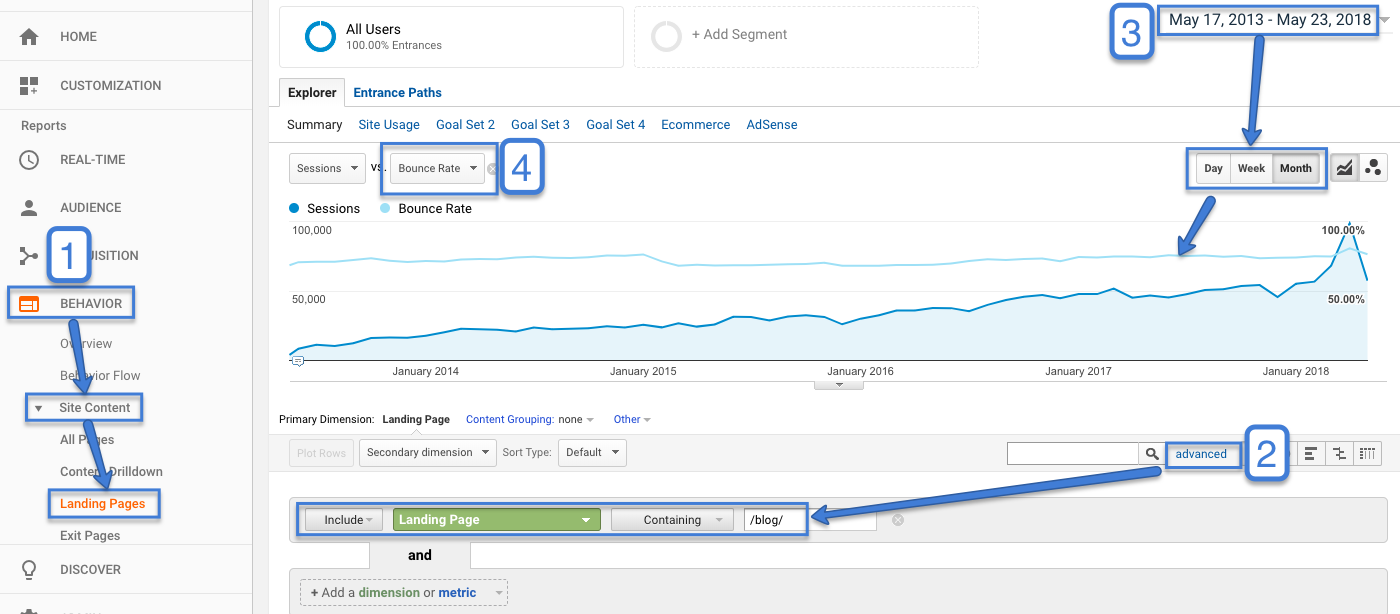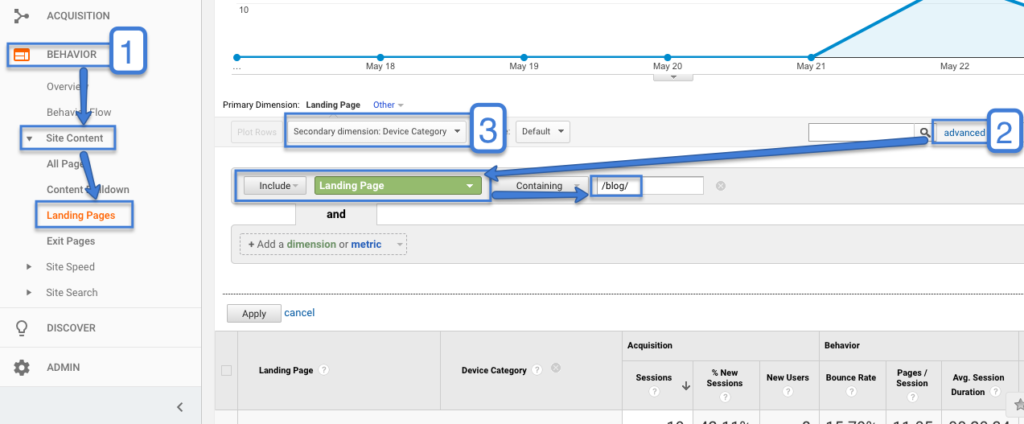How to Understand and Reduce your Blog's Bounce Rate
In this post we'll discuss how to lower the bounce rate of your blog, and set better bounce rate benchmarks.
Bounce Rates on a Blog can be hard to wrap your head around, and even harder to actively impact.
In this post we seek to answer a few questions:
- What is bounce rate?
- What is a typical bounce rate for a blog?
- How do you reduce the bounce rate on your blog?
Stick with me here, and we'll take a look at how to come up with your own benchmark for bounce rate, and then take actionable steps to trounce the bounce!

What is Bounce Rate anyway?
[bctt tweet="Bounce rate is not technically the percentage of single-page visitors to a site as defined by Google, but actually the percentage of single-interaction visitors to the site."]
In other words, if a visitor arrives at your site and performs an action or event, such as watching a video or filling out a form, that is not considered a bounce. A visit is only technically a bounce if the user leaves without taking ANY action on the page.
It can be a tricky metric to pin down.
[bctt tweet="Bounce Rate can be one of the more confusing metrics in Google Analytics due to the fact that it's very hard to concisely pin down what a 'good' bounce rate is."]
This is a result of the fact that bounce rate varies heavily based on User Intent, Content Type, and even factors such as Traffic Source or Device.
Concerned About your Bounce Rate?
We'll check it out! Happy with your overall SEO but need help improving your blog's bounce rate? We offer a comprehensive audit that can be tailored to your needs.
Establishing Expectations: What is a "Normal" Bounce Rate for a Blog?
[bctt tweet="What is a 'normal' bounce rate for your blog? TL;DR version: 'It varies'."]

When dealing with content marketing, expectations often have to be adjusted. Even if your team has invested heavily in the idea that content marketing works, it’s still important that we lay out the following points:
Expectation #1: Bounce Rate is VERY subjective
Bounce rate varies widely from industry to industry, and even from site to site. This variety can be brought about by any number of factors, for example, user intent, content type, traffic source, and even the type of device the visitor is using.
Therefore, it’s very difficult, bordering on impossible to establish an accurate benchmark for what makes a ‘Good’ Bounce Rate.
[bctt tweet="Bounce rate is VERY subjective and varies heavily based on User Intent, Content Type, and even factors such as Traffic Source or Device."]
Expectation #2: Bounce Rate will vary even within your site
Realistically speaking, you should get pretty granular regarding your Bounce Rate expectations. For instance, the accepted bounce rate on your service pages should be expected to be different to the bounce rate on your blog posts.
This largely comes down to user intent. Someone who arrives at a blog post is typically looking for information, which they find, and then typically they ‘bounce’. Someone who arrives at a service page is far more likely to navigate deeper into your site.
Expectation #3. Content Marketing requires multiple touches.
Converting a user via your blog can often be a battle of attrition. Current statistics show that content marketing takes on average 7-13 ‘touches’ before a sale is made.
In other words, a potential user has to encounter your brand via your blog, social media or some other source upwards of 7 times before being confident enough to commit.
"For example, at Moz, we find the average relationship has
seven to eight customer touchpoints before conversion."
So, with all those expectations set and disclaimers out of the way... What is a typical healthy bounce rate for a blog?
I'm afraid it doesn't get any clearer. Here are the findings from some industry leaders:
QuickSprout
In 2014, Quicksprout put together an infographic showing that blogs can experience a bounce rate anywhere between:
70-98%
CustomMediaLabs
However, in 2016, CustomMediaLabs put together a post showing that they found that blog bounce rates can frequently range between:
65-90%
So, with all those expectations set and disclaimers out of the way... What is a typical healthy bounce rate for a blog?
I'm afraid it doesn't get any clearer. Here are the findings from some industry leaders:
[bctt tweet="Depending on the source you're looking at, blog bounce rates typically vary between 65-98%. That variance is far too wide to be of any real use."]
In the absence of any really reliable benchmarks for blog Bounce Rates, there's only one logical course of action. Establish your own.
"Set Your Own Baseline Rather than worrying about keeping up with the Joneses and their fancy 29% bounce rate, set a baseline for your website, and work to improve it"
GoRocketFuel.com, What's the Average Bounce Rate for a Website?
Setting a benchmark Bounce Rate for your blog
So, how do you go about settling on a benchmark for your blog?
First, Perform An Audit of your current Blog Bounce Rate:
I recommend a review of the bounce rate for traffic to your blog from three perspectives:
- Traffic arriving from different sources: Organic, Direct, Referral, etc.
- Traffic from different devices: Mobile, Desktop, Tablet, etc.
- Finally, bounce rate fluctuations over the last several years.
[bctt tweet="Before you can improve your bounce rate, you need to ensure that it isn’t high because of a specific user demographic, or a change you've implemented over the past few years."]
Part 1: Review your Bounce Rate history:
In order to do this, follow these 3 steps (also outlined in the screenshot below). With this knocked out, you should be able to identify any changes over time that have led to a higher than ideal bounce rate, and possibly undo them.
- Go to the Landing Pages report in Analytics
- In "Advanced Filters", restrict the visible landing pages down to just your blog. Note that if you use /news/ or some other file name for your blog, you'll need to do that here also.
- Adjust your date range to go back as far as you'd like, or as far as you have data. (You may also want to adjust your view to weekly or monthly increments for clarity.)
- Click "Select a metric" near sessions, and choose "Bounce Rate from the drop-down.
(Click image to enlarge)
Part 2: Review your Bounce Rate from different sources, and on different devices:
In order to do this, follow these 3 steps (also outlined in the screenshot below). The primary goal is to isolate any trends or problem areas that may be contributing to a higher than ideal bounce rate.
- Go to the Landing Pages report in Analytics
- In "Advanced Filters", restrict the visible landing pages down to just your blog. Note that if you use /news/ or some other file name for your blog, you'll need to do that here also.
- Now, use the Secondary Dimension dropdown to pull up "Device Category" and then "Source", looking for any patterns.
(Click image to enlarge)
If you've ruled these out, chances are your bounce rate has slowly crept up and reducing it is a matter of observing and implementing changes that will help.
It’s worth noting that it’s unlikely you’ll find a ‘silver bullet’ that will fix your bounce rate overnight. It’s much more likely that you'll need to gradually implement changes and slowly knock the bounce rate down.
Super Actionable Takeaway: Take the 1-post challenge!
Tired of fluff posts that don't move your marketing forward? This is not one of those posts!
Here's my challenge to you:
In your next blog post: Implement as many as possible of the best practices below.
Rules:
- Make sure it’s a post you’re happy with from a content perspective, and also be sure you've got a good idea of what a typical blog post bounce rate on your site looks like.
- Depending on how much traffic your post gets per day/week you should soon be able to see whether your bounce rate is better than average for your site.
- Don't draw premature conclusions. You need at least 100 sessions, preferably several hundred before it's safe to start drawing conclusions.
- If your bounce rate has improved (read: gotten lower), you now know the steps needed to improve all of your other blog posts.
- If it hasn’t, keep in mind that the bounce rate you've been experiencing may just be a realistic percentage based on your industry, target audience, etc.
I'm willing to bet you'll see some measurable improvement though.
[bctt tweet="I took the 1-Post Bounce Rate Optimization for Blogs Challenge, from @LoftyRankings!"]

Here goes! The part you've been waiting for:
How to Decrease Bounce Rate on your blog:
TL;DR Recap:
- A Bounce Rate is the percentage of people who leave without interacting with your site in any way.
- Bounce Rates are highly subjective. Set a benchmark for yours by auditing what you've experienced from different types of users in the past.
- It's hard to know if your bounce rate could be improved without simply trying. Take the 1 post challenge! If your trial post has a fantastic Bounce Rate, now you know what to do to all of your other posts.
- We provided a list of good bounce rate reducing practices.
- Don't have the time/energy/expertise to fix your own blog's bounce rate? Have us fix it for you!
Feel like your Blog needs a little extra TLC?
We'll help you out. We've got the skills to turn your blog around!
This post was the result of a LOT of work, and not just from me. I owe a lot of credit to the authors of the following:



What an awesome and informative article! I loved your step-by-step instructions, and definitely learned some new tricks!
Thanks, Caroline! I appreciate the feedback! (Hope you’re doing well!)
I rattling delighted to find this web site on bing, just what I was searching for : D as well saved to favorites.
Thanks, Neoma!
Glad you found it helpful!
Great advices there!
I think when my free report will be fnished and that I’ll have an opt-in, I’ll implement the exit popup.
I’ll also try to incorporate an ivite to comment in the first few sentences.
Thank you for this post!
Thanks, Frédéric!
I hope it helps improve your bounce rate!
[…] Trounce the Bounce! How to Reduce Blog Post Bounce Rates […]
I’ll right away snatch your rss as I can’t in finding your email subscription hyperlink or e-newsletter service.
Do you’ve any? Kindly let me recognize in order that I could
subscribe. Thanks. I couldn’t resist commenting.
Well written! I couldn’t resist commenting. Well written!
Hi Jim, thanks for the message! I’m afraid I don’t have an email newsletter at the moment, although I’ll be working on that once I’m producing content more regularly. Stay tuned for that in the future though!